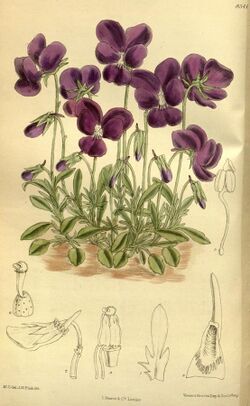Biology:Viola gracilis
| Viola gracilis | |
|---|---|

| |
| Scientific classification | |
| Kingdom: | Plantae |
| Clade: | Tracheophytes |
| Clade: | Angiosperms |
| Clade: | Eudicots |
| Clade: | Rosids |
| Order: | Malpighiales |
| Family: | Violaceae |
| Genus: | Viola |
| Species: | V. gracilis
|
| Binomial name | |
| Viola gracilis | |
| Synonyms[1] | |
| |
Viola gracilis, also known as the Olympian violet,[2] is a species of flowering plant within the family Violaceae.[3]
Description
Viola gracilis is a perennial species, which grows to form dense mats. Leaves are ovate to oblong and range from 2–3 cm long.[4] Plants possess decumbent based stems,[5] which can range from 5–30 cm long.[4] Plants flower between May and August. Flowers can be yellow or violet in colour, but never bicoloured.[4] The spur of the flower is 6-7mm and can be straight or slightly curved. Stipules have oblanceolate, spathulate lobes.[4]
Distribution
Viola gracilis is native to Europe where it can be found in the countries of Albania, Bulgaria, Yugoslavia and Turkey. Turkish populations are only present in western Turkey.[1]
Habitat
Viola gracilis grows in grassy mountain woodlands and alpine meadows.[4] It can also be found growing amongst rocks.[5] It has been recorded growing at altitudes ranging from 1250 to 2000 meters above sea level.[4]
References
- ↑ 1.0 1.1 "Viola gracilis" (in en). Royal Botanic Gardens, Kew. http://www.plantsoftheworldonline.org/taxon/868245-1.
- ↑ "Viola gracilis Olympian violet". 2022-05-21. https://www.rhs.org.uk/plants/18995/viola-gracilis/details.
- ↑ "Viola gracilis Sm.". 2022-05-21. http://www.worldfloraonline.org/taxon/wfo-0000423927.
- ↑ 4.0 4.1 4.2 4.3 4.4 4.5 Phillips, Rix, Roger, Martyn (1991). Perennials Volume 1 Early Perennials. Pan Books. pp. 55. ISBN 0330327747.
- ↑ 5.0 5.1 "Viola gracilis". 2022-05-21. http://encyclopaedia.alpinegardensociety.net/plants/Viola/gracilis.
Wikidata ☰ Q17564279 entry
This article needs additional or more specific categories. (May 2022) |
 |

